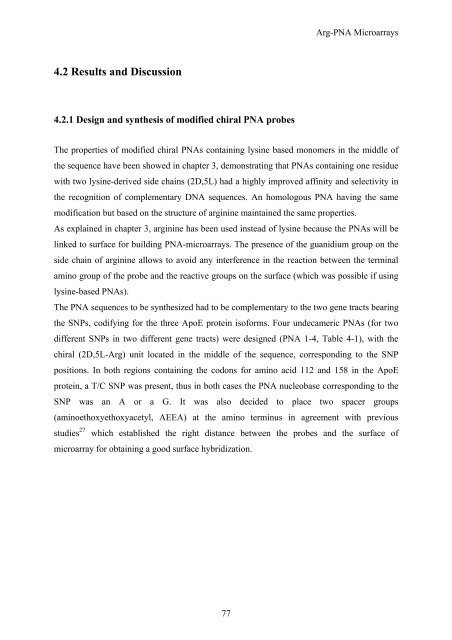View - DSpace UniPR
View - DSpace UniPR
View - DSpace UniPR
You also want an ePaper? Increase the reach of your titles
YUMPU automatically turns print PDFs into web optimized ePapers that Google loves.
Arg-PNA Microarrays<br />
4.2 Results and Discussion<br />
4.2.1 Design and synthesis of modified chiral PNA probes<br />
The properties of modified chiral PNAs containing lysine based monomers in the middle of<br />
the sequence have been showed in chapter 3, demonstrating that PNAs containing one residue<br />
with two lysine-derived side chains (2D,5L) had a highly improved affinity and selectivity in<br />
the recognition of complementary DNA sequences. An homologous PNA having the same<br />
modification but based on the structure of arginine maintained the same properties.<br />
As explained in chapter 3, arginine has been used instead of lysine because the PNAs will be<br />
linked to surface for building PNA-microarrays. The presence of the guanidium group on the<br />
side chain of arginine allows to avoid any interference in the reaction between the terminal<br />
amino group of the probe and the reactive groups on the surface (which was possible if using<br />
lysine-based PNAs).<br />
The PNA sequences to be synthesized had to be complementary to the two gene tracts bearing<br />
the SNPs, codifying for the three ApoE protein isoforms. Four undecameric PNAs (for two<br />
different SNPs in two different gene tracts) were designed (PNA 1-4, Table 4-1), with the<br />
chiral (2D,5L-Arg) unit located in the middle of the sequence, corresponding to the SNP<br />
positions. In both regions containing the codons for amino acid 112 and 158 in the ApoE<br />
protein, a T/C SNP was present, thus in both cases the PNA nucleobase corresponding to the<br />
SNP was an A or a G. It was also decided to place two spacer groups<br />
(aminoethoxyethoxyacetyl, AEEA) at the amino terminus in agreement with previous<br />
studies 27 which established the right distance between the probes and the surface of<br />
microarray for obtaining a good surface hybridization.<br />
77
















